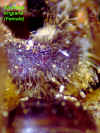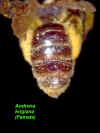Subgenus Callandrena (5 species)
Includes 3 fall flying species (A. accepta, A. asteroides, and A.
fulvipennis) and 2 spring-flying species (A.
gardineri and A. krigiana). LaBerge places each
of these species into separate species groups. These subgenus has unusually
short maxillary palpi in both sexes. These are usually shorter than the galea
when stretched forward. Females have highly plumose tibial scopal hairs,
flattened emarginate labral process, and narrow pterostigma. Males have the
narrow pterostigma, yellow clypeus, often with yellow parocular areas, and flat
emarginate labral process. Both sexes lack the pronotal humeral angles and
ridges, usually with tergal fasciae, and finely sculptured propodeal
enclosures.
For more information, see LaBerge, Wallace E. 1967. A revision of the bees of
the genus Andrena of the Western Hemisphere. Part I. Callandrena (Hymenoptera:
Andrenidae). Bulletin of the University of Nebraska State Museum 7:1-316.
Key to Females of Callandrena
- Hind tarsal claws distinctly smaller than middle and fore tarsal claws;
mandible abruptly narrowed about one-third distance from base, least width
(near mandible) equal to half or less of greatest width (near base); fore
wings deeply infumate, dark blackish-brown…A.
fulvipennis Smith


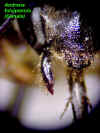

Hind tarsal claws as large as or larger than fore and middle tarsal claws;
mandible usually not abruptly broadened near base (without basoventral
lamella), or if so, then fore wings not deeply infumate, clear to moderate
infumation….2

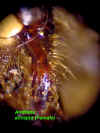
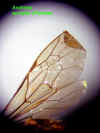
- Propodeal corbicula with interior free of hairs or with several long hairs
restricted to dorsoposterior third, or with minute hairs scattered over
surface, anterior margin without long plumose hairs…A.
krigiana Robertson
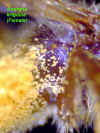
---Propodeal corbicula with interior with long simple or plumose hairs
scattered throughout or concentrated in upper half or anterodorsal area, if
anterior without long hairs, then anterior margin with long plumose hairs
(corbicula complete)…..3

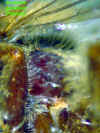
- Clypeus and/or parocular areas with yellow or cream-colored markings…A.
accepta Viereck
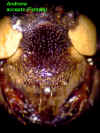
---Clypeus and parocular areas black….4.
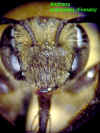
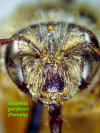
- Small to medium sized bees (11mm or less in length), facial fovea short,
not extending down beyond level of upper margins of antennal fossa,
spring-flying species…A.
gardineri Cockerell
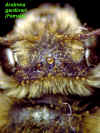
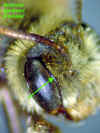
---Medium-sized to large bees, usually 11mm or more in length, or if
smaller, than facial fovea extends down to about lower margins of antennal
fossa (fovea often short in larger forms); fall-flying species…A.
asteroides Mitchell


Key to males of Callandrena in Florida (from Mitchell)
1. With conspicuous yellow maculae between clypeus and eye...2
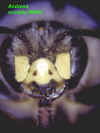
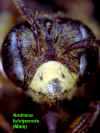
Lateral face marks either lacking or with mere traces of yellow along clypeal
margin which do not extend to margin of eye...3
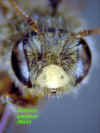
2. Lateral face marks large, extending to level of antennae...A.
accepta

Lateral face marks small, not nearly attaining level of upper margin of
clypeus...A. fulvipennis

3. Basal segment of flagellum considerably shorter than segments 2 and 3
combined..A. asteroides.
Basal segment of flagellum nearly or quite equal in length to segments 2 and
3 combined..4
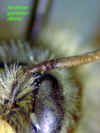
4. Lateral angles of sternum 6 strongly reflexed...A.
gardineri
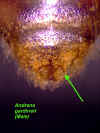
Lateral angles of sternum 6 not reflexed...5
5. Lateral and upper margins of clypeus dark; segments 2-4 of flagellum very
short, their combined length not much exceeding the basal segment...A.
krigiana
Clypeus entirely yellow; at least 4th segment of flagellum fully as long as
broad..A. fulvipennis
Note depending on the extent of the clypealocular maculation, A.
fulvipennis comes out twice in the key.
Andrenidae: Andrena (Callandrena) accepta Viereck
County Records: Leon
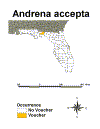
Locations: Tall Timbers Research Station
Dates: Oct. 16-Nov. 7.
Plant:
Notes: New state record for Florida, prev. collected in Georgia. This is one
of three fall-flying Callandrena.
Female: 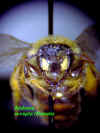
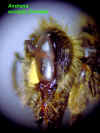

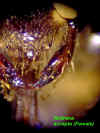
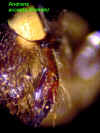

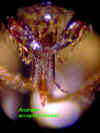











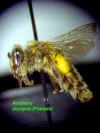



Male: 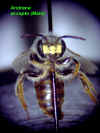


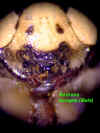
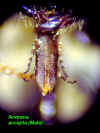

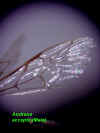










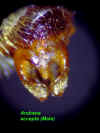
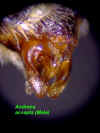
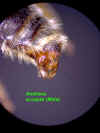

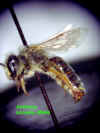
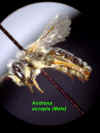
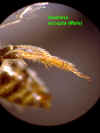
Andrenidae: Andrena (Callandrena) asteroides Mitchell
County Records: Found in Thomas Co, GA, may be found in Florida
Locations:
Dates: fall flying
Plant: New state record for Georgia
Notes:
Female: 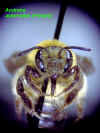
















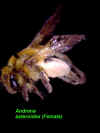


Andrenidae: Andrena (Callandrena) fulvipennis Smith
County Records: Alachua, Baker, Bay, Clay, Columbia, Escambia, Gulf, Leon,
Marion, Okaloosa, Putnam, Pasco, Santa Rosa, Volusia, Wakulla
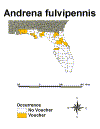
Locations: Blackwater River State Forest, Daytona Beach, Destin, Interlachen,
St. Andrews State Park, St. Joseph, St. Marks National Wildlife Refuge, Tall
Timbers
Dates: Sept. 11-Nov. 5, Sept.:1, Oct: 13, Nov:2
Plant:
Notes:
Female: 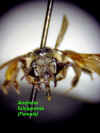
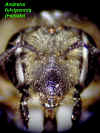
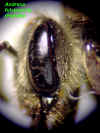

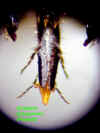












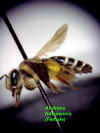





Male: 
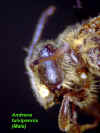

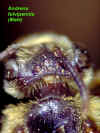

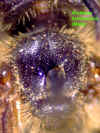
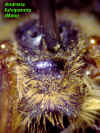
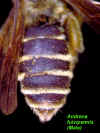

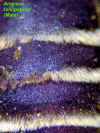
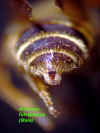
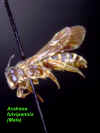
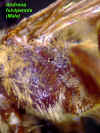

Andrenidae: Andrena (Callandrena) gardineri Cockerell
County Records: Jackson, Liberty
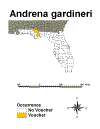
Locations:
Dates: March 19-April 13, March:1, April:1
Plant: Senecio glabellus (Specialist on Senecio?)
Notes: New state record for Florida, previously collected in Georgia. Spring
flying.
Female: 

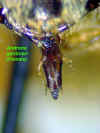

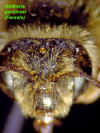
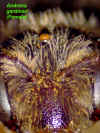


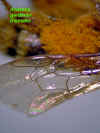
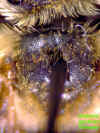
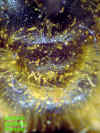
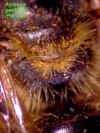

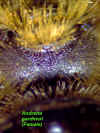



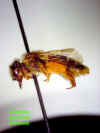

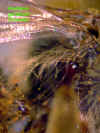

Male: 


Andrenidae: Andrena (Callandrena) krigiana Robertson
(Callandrena)
County Records: Alachua, Suwanee
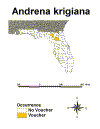
Locations:
Dates: March 20-April 25
Plant:
Notes: New state record for Florida, previously collected in Georgia. This is
an early summer species in the southeastern United States.
Female: 




